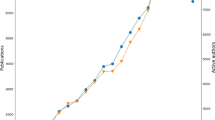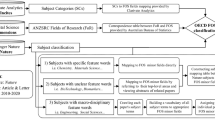Abstract
We study the discrepancy between two ways of classifying publications in the social sciences and humanities (SSH): on the basis of the contents of publications and publication channels (cognitive classification) or on the basis of the organizational structure of departments, faculties etc. (organizational classification). Using data for the period 2000–2015 from 76,076 peer reviewed publications (co-)authored by SSH researchers affiliated to a Flemish university, we compare the organizational classification of the publications with a cognitive classification based on OECD Fields Of Science. In all fields except one, the cognitive discipline with the most publications is the one that most closely matches the organizational discipline, although there are substantial differences between disciplines in terms of overlap and concentration. At a higher aggregation level, we find that 73% of publications from the humanities are published in humanities publication channels, while this is only the case for 59% of publications from the social sciences. Social sciences are shown to have important links to medicine and health sciences. The spread of publications over cognitive disciplines, including non-SSH disciplines, is only partially related to the assignment of some publication channels to multiple FOS fields as well as multidisciplinary collaboration. Our study shows that it is quite common for researchers affiliated to an organizational unit to also carry out research in other domains.





Similar content being viewed by others
Notes
An updated version of the Frascati Manual (OECD 2015) refers to these as the Fields of Research and Development (FORD),—apart from a few superficial name changes the fields themselves remain unchanged in the newer version.
References
Abbott, A. (2001). Chaos of disciplines. Chicago: University of Chicago Press.
Bod, R. (2012). Het Einde van de Geesteswetenschappen 1.0. Amsterdam: Universiteit van Amsterdam. Retrieved May 2, 2018 from http://www.oratiereeks.nl/upload/pdf/PDF-1433Weboratie_Rens_Bod_-_def.pdf.
Börner, K., Klavans, R., Patek, M., Zoss, A. M., Biberstine, J. R., Light, R. P., et al. (2012). Design and update of a classification system: The UCSD map of science. PLoS ONE, 7(7), e39464. https://doi.org/10.1371/journal.pone.0039464.
Bowker, G. C., & Star, S. L. (2000). Sorting things out: Classification and its consequences. Cambridge, MA: MIT Press.
Boyack, K. W., & Klavans, R. (2014). Including cited non-source items in a large-scale map of science: What difference does it make? Journal of Informetrics, 8(3), 569–580. https://doi.org/10.1016/j.joi.2014.04.001.
Daraio, C., & Glänzel, W. (2016). Grand challenges in data integration—State of the art and future perspectives: An introduction. Scientometrics, 108(1), 391–400. https://doi.org/10.1007/s11192-016-1914-5.
Frickel, S., & Ilhan, A. O. (2017). Disciplinary and interdisciplinary change in six social sciences: A longitudinal comparison. In S. Frickel, M. Albert, & B. Prainsack (Eds.), Investigating interdisciplinary collaboration: Theory and practice across disciplines (pp. 148–169). New Brunswick, NJ: Rutgers University Press.
Gini, C. (1921). Measurement of inequality of incomes. The Economic Journal, 31(121), 124–126.
Guns, R., Engels, T. C. E., & Verleysen, F. T. (2017). Cognitive and organizational classification of publications in the social sciences and humanities. In Proceedings of the 16th international conference on scientometrics and informetrics (pp. 112–117). Wuhan: Wuhan University.
Hay, C. (2010). The changing nature of european political science: The discipline in an age of acknowledged interdependence. European Political Science, 9(1), S121–S131. https://doi.org/10.1057/eps.2010.41.
Hicks, D. (2004). The four literatures of social science. In H. F. Moed, W. Glänzel, & U. Schmoch (Eds.), Handbook of quantitative science and technology research: The use of publication and patent statistics in studies of S&T systems (pp. 473–496). Dordrecht: Kluwer Academic.
Huutoniemi, K., & Rafols, I. (2016). Interdisciplinarity in research evaluation (SSRN Scholarly Paper No. ID 2818321). Rochester, NY: Social Science Research Network. Retrieved April 28, 2018 from https://papers.ssrn.com/abstract=2818321.
Klavans, R., & Boyack, K. W. (2009). Toward a consensus map of science. Journal of the Association for Information Science and Technology, 60(3), 455–476. https://doi.org/10.1002/asi.20991.
Kulczycki, E., Engels, T. C. E., & Nowotniak, R. (2017). Publication patterns in the social sciences and humanities in Flanders and Poland. In Proceedings of the 16th international conference on scientometrics and informetrics (pp. 95–104), Wuhan.
Kulczycki, E., Engels, T. C. E., Pölönen, J., Bruun, K., Dušková, M., Guns, R., et al. (2018). Publication patterns in the social sciences and humanities: Evidence from eight European countries. Scientometrics. https://doi.org/10.1007/s11192-018-2711-0. (in press).
Lamont, M. (2009). How professors think: Inside the curious world of academic judgment. Cambridge, MA: Harvard University Press.
Leydesdorff, L., & Bornmann, L. (2016). The operationalization of “fields” as WoS subject categories (WCs) in evaluative bibliometrics: The cases of “library and information science” and “science & technology studies.” Journal of the Association for Information Science and Technology, 67(3), 707–714. https://doi.org/10.1002/asi.23408.
Marcovich, A., & Shinn, T. (2011). Where is disciplinarity going? Meeting on the borderland. Social Science Information, 50(3–4), 582–606. https://doi.org/10.1177/0539018411411036.
Marcovich, A., & Shinn, T. (2012). Regimes of science production and diffusion: Towards a transverse organization of knowledge. Scientiae Studia, 10(SPE), 33–64. https://doi.org/10.1590/S1678-31662012000500003.
Nederhof, A. J. (2006). Bibliometric monitoring of research performance in the social sciences and the humanities: A review. Scientometrics, 66(1), 81–100. https://doi.org/10.1007/s11192-006-0007-2.
Organisation for Economic Co-operation and Development. (2007). Revised field of science and technology (FOS) classification in the Frascati manual. Paris: Working Party of National Experts on Science and Technology Indicators, Organisation for Economic Co-operation and Development. https://doi.org/10.1787/9789264239012-en.
Organisation for Economic Co-operation and Development. (2015). Frascati manual 2015: Guidelines for collecting and reporting data on research and experimental development. Paris: OECD Publishing. https://doi.org/10.1787/9789264239012-en.
Ossenblok, T. L. B., Engels, T. C. E., & Sivertsen, G. (2012). The representation of the social sciences and humanities in the Web of Science—A comparison of publication patterns and incentive structures in Flanders and Norway (2005–9). Research Evaluation, 21(4), 280–290.
Pedersen, D. B. (2016). Integrating social sciences and humanities in interdisciplinary research. Palgrave Communications, 2, 16036. https://doi.org/10.1057/palcomms.2016.36.
Poelmans, H., & Vancauwenbergh, S. (2017). Development of the Flemish research discipline list: State of affairs. Presented at the ECOOM Conference, Hasselt.
Pölönen, J., Engels, T. C. E., Guns, R., Sivertsen, G., & Verleysen, F. T. (2017). SSH journal publishing in Flanders and Finland. Presented at the 2nd Conference on Research Evaluation in the Social Sciences and Humanities, Antwerp, Belgium.
Pudovkin, A. I., & Garfield, E. (2002). Algorithmic procedure for finding semantically related journals. Journal of the American Society for Information Science and Technology, 53(13), 1113–1119. https://doi.org/10.1002/asi.10153.
Rousseau, R. (2011). Lorenz curves determine partial orders for comparing network structures. DESIDOC Journal of Library & Information Technology, 31(5), 340–347.
Suominen, A., & Toivanen, H. (2016). Map of science with topic modeling: Comparison of unsupervised learning and human-assigned subject classification. Journal of the Association for Information Science and Technology, 67(10), 2464–2476. https://doi.org/10.1002/asi.23596.
Van Eck, N. J., & Waltman, L. (2010). Software survey: VOSviewer, a computer program for bibliometric mapping. Scientometrics, 84(2), 523–538. https://doi.org/10.1007/s11192-009-0146-3.
van Leeuwen, T. (2013). Bibliometric research evaluations, Web of Science and the Social Sciences and Humanities: A problematic relationship? Bibliometrie-Praxis Und Forschung, 2, 1–18. https://doi.org/10.5283/bpf.173.
van Rijnsoever, F. J., & Hessels, L. K. (2011). Factors associated with disciplinary and interdisciplinary research collaboration. Research Policy, 40(3), 463–472. https://doi.org/10.1016/j.respol.2010.11.001.
Verleysen, F. T., Ghesquière, P., & Engels, T. C. E. (2014). The objectives, design and selection process of the Flemish Academic Bibliographic Database for the Social Sciences and Humanities (VABB-SHW). In W. Blockmans, L. Engwall, & D. Weaire (Eds.), Bibliometrics. Use and abuse in the review of research performance (pp. 117–127). London: Portland Press. Retrieved from http://www.portlandpress.com/pp/books/online/wg87/087/0117/0870117.pdf.
Verleysen, F. T., & Weeren, A. (2016a). Clustering by publication patterns of senior authors in the social sciences and humanities. Journal of Informetrics, 10, 254–272. https://doi.org/10.1016/j.joi.2016.01.004.
Verleysen, F. T., & Weeren, A. (2016b). Mapping diversity of publication patterns in the social sciences and humanities. An approach making use of fuzzy cluster analysis. Journal of Data and Information Science, 3(1), 1–27.
Whitley, R. (2000). The intellectual and social organization of the sciences. Oxford: Oxford University Press.
Acknowledgements
The present study is an extended version of an article presented at the 16th International Conference on Scientometrics and Informetrics, Wuhan (China), 16–20 October 2017). This investigation has been made possible by the financial support of the Flemish government to ECOOM. We thank Emanuel Kulczycki and Sadia Vancauwenbergh for feedback on specific issues.
Author information
Authors and Affiliations
Corresponding author
Electronic supplementary material
Below is the link to the electronic supplementary material.
Rights and permissions
About this article
Cite this article
Guns, R., Sīle, L., Eykens, J. et al. A comparison of cognitive and organizational classification of publications in the social sciences and humanities. Scientometrics 116, 1093–1111 (2018). https://doi.org/10.1007/s11192-018-2775-x
Received:
Published:
Issue Date:
DOI: https://doi.org/10.1007/s11192-018-2775-x




